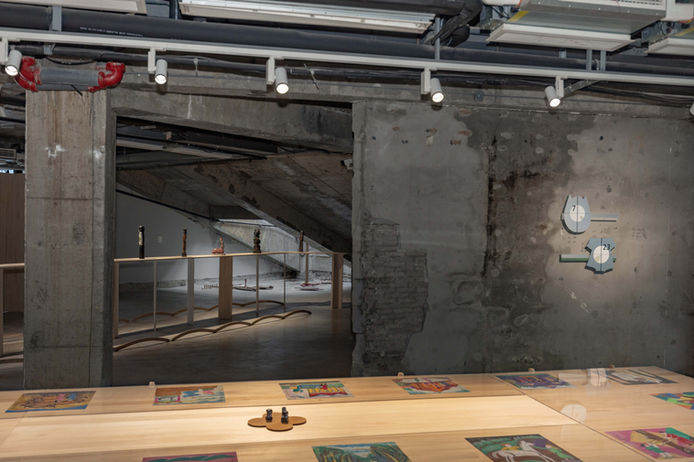
drifting encounters
2025.8.4-2025.10.26
group exhibition
Curator:yang tiange
Though a static exhibition, Drifting Encounters unfolds like a continuous drama.
Ding Liren is the point of departure—but how could an “encounter” occur with only one player? A single clap makes no sound; a solo rendezvous breeds only solitude. As such, Drifting Encounters is not a solo show in the conventional sense. It is an ensemble production. These new participants engage, intervene, contaminate, provoke. Together, they enact a dynamic interplay of recognition and departure—a scene that begins, but never quite ends.
At once a drama and a game, this exhibition mirrors Ding’s approach to life and art: playful, curious, and ever open to joy. Along the way, he has often found fellow travelers—kindred spirits with whom to share a drink or a walk. In Drifting Encounters, every participant plays a role; logic is suspended, age irrelevant. Like a teeming stage on a cosmopolitan street, the show revels in its variety. One moment bursts with chaos, the next with heartfelt exchange. As the saying goes: the elder artist becomes young again, humble among the ensemble; while the young perform with a flair for legend.
Consider the younger artists who’ve come to “encounter” Ding: Ge Yulu, ever the outlier, refrains from creating new work himself, instead curating a mini-exhibition of artist Zhan Qi—a “show within a show”—as a gesture of introduction and encounter. Hu Yinping revisits her ongoing series “What did the masters come to the east for?”, producing a new episode of Xiaofang in the visual style of Ding’s early works, paying tribute to his deep affinity with grassroots culture. Li Xindi devises a set of rules for an interactive installation that redefines “encounter” as the evolving relationship between viewer and exhibition—a script written through movement. Liu Dongxu reimagines household items into sculptures that echo both classical and modernist vocabularies, staging a formal encounter across time. Su Hua paints scenes teeming with unruly vitality—markets, rivers, martial worlds—unfolding with ceaseless energy. Wu Shangcong repurposes discarded materials into narratives that bridge sculpture and painting, dissolving boundaries in a manner deeply resonant with Ding’s spirit.
Drifting Encounters speaks to those open to chance, to those with heart. One talks art, another speaks of life; one shares history, another spins tales. You may be solemn, while the next is gleeful—mismatched tones are the point, while contradictions live together. This is art as game, achieved only through non-striving, where the child creates effortlessly and the elder lets go of mastery. To keep one’s innocence untarnished—this is the highest aim, and the hardest to attain. The confused may stumble into insight; the fixated will surely miss it. Its secret may seem distant, inspiring awe from afar; or it may feel intimate, revealing one’s innermost nature and true self. Drifting Encounters is, above all, a gesture of openness—a wish to spark unexpected connection.
At Beiqiu Museum of Contemporary Art, this “encounter” unfolds as a meeting of landscape and mind, connected by a “Nine-Turn Bridge”. Drawn from Ding’s painting, the Nine-Turn Bridge has been brought to life as a physical exhibition platform—carefully designed and subtly woven through the museum’s terrain. Along this winding path, scenes of encounter unfold one after another. The drama is rich and varied—too much to count—but here are a few teasers: the fantasy and fairy tales of Drifting Encounters; Lijiazhaij, tracing Shanghai’s transformation from countryside to city; A rural school life from 80 years ago, still vivid today; New rewritings of legendary tales: Journey to the West, Twin Spears, and Yang the Chivalrous, reimagined with battle cries and mythic flair. In short: a magnificent spectacle, born of small, playful art pieces.













